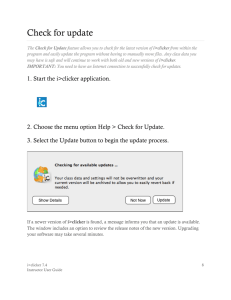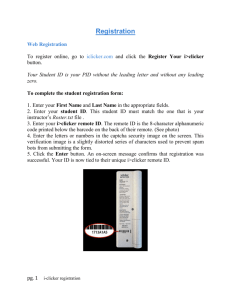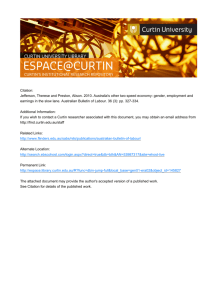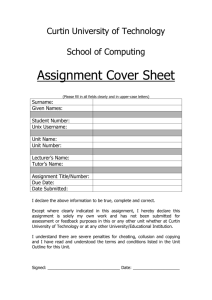How do we balance science & practice in pharmacy curricula? Physical sciences
advertisement
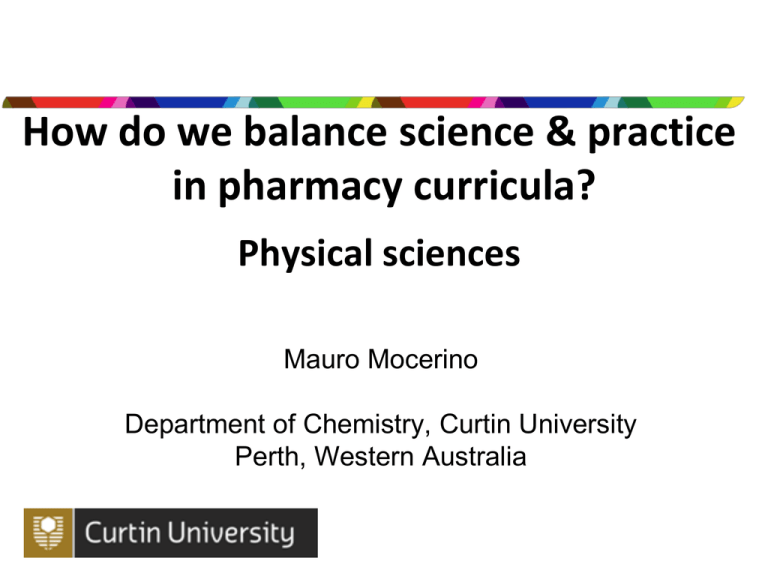
How do we balance science & practice in pharmacy curricula? Physical sciences Mauro Mocerino Department of Chemistry, Curtin University Perth, Western Australia Professional competencies A selection from Curtin B. Pharm course • Compound pharmaceutical products • Participate in therapeutic decision making • Evaluate prescribed medicines • Evaluate and synthesise information • Apply communication skills and participate in negotiations • Prepare cytotoxic drug products • Explore problems/potential problems Professional competencies A selection from Curtin B. Pharm course • Compound pharmaceutical products • Participate in therapeutic decision making • Evaluate prescribed medicines • Evaluate and synthesise information • Apply communication skills and participate in negotiations • Prepare cytotoxic drug products • Explore problems/potential problems Process skills When do students develop these? Process skills When do students develop these? Or more specifically When do we give students opportunities to develop these process skills? Active Learning in University Science Pedagogy Process Oriented Guided Inquiry Learning The student is guided through the An exploration of a model by a set of questions concept, application of a allowing them to construct their own theory or experimental knowledge and test the knowledge data is presented in a in applications of the theory or model or series of models concept http://www.pogil.org/ Thinking About Process Skills POGIL’s targeted process skills 1.Oral & written communication 2.Teamwork 3.Problem solving 4.Critical & analytical thinking 5.Team & self-management 6.Information processing 7.Assessment & self-assessment Learning cycle paradigm Sample activity Molecular formula C4H8O2 Condensed structure HOCH2CH2COCH3 H2 C C5H11N H2C H2C "Lewis" Structure H O H H O H C C C C H H H H H CH NH2 C CH3CHCHCH2CCCH3H H C C H H NH2 H C HH C6H8 HO H H H H N C C O H H C CH2 Line structure H H H C C H C C H Sample activity ‣ Provide a table showing common representation styles for organic molecules ‣ Ask student questions to explore the styles ‣ Have students develop their own rules for using the line structure style ‣ Have them apply their rules in some questions Folders ‣ Each student is assigned a team ‣ Each team is given a folder ‣ Names of the elements Xe Xenon ‣ Folders are distributed at the start of the class and returned at the end of the class ‣ A copy of the day’s activity is provided (on coloured paper) ‣ Teams are also given communication tools via Blackboard Teams Manager Keeps the group ontrack, delegates tasks to other team members Recorder Presenter Keeps the record of the group activity on the copy provided Asks questions of the lecturer and enters clicker answers Teams of three Teams Manage Recorder Reflector Presenter Teams of four Keeps a reflection on the groups progress and performance Sample Lecture slide Class Activity: Reactions of alkanes Group Roles: Manager: Responsible for keeping group on task and ensuring all members have an input Recorder: Responsible for recording the groups answers on the coloured activity sheets (should sit in the middle of the group) Presenter: Responsible for asking and answering questions for the group (including clicker questions) Today's allocation: Recorder - the person who has their birthday earliest in the year. Manager- the person to the right of the recorder Presenter - the person to the left of the recorder Clicker question in 5 minutes Clickers ‣ Audience response system ‣ Allows immediate feedback ‣ Revision of previous lecture’s concepts ‣ Can easily monitor progress ‣ Useful teaching tool ‣ Can be used for assessment Sample clicker question Highlights of last lecture What is the number of stereocentres in nootkatone (grapefruit oil) shown below? O 1. 2. 3. 4. 5. 6. none one two three four five Feedback clicker question Highlights of last lecture What is the number of stereocentres in nootkatone (grapefruit oil) shown below? 30 25 O 1. 2. 3. 4. 5. 6. none one two three four five 20 15 10 5 0 1 2 3 4 5 6 Outcomes C101 & C102 ‣ Class attendance is improved ‣ Improvement in some traditionally poor areas ‣ MO theory ‣ Coordination chemistry ‣ Mechanisms and use of curved arrows ‣ Student feedback is very positive Outcomes - US data ‣ Common exam data Key A B C D, F or W Institution A Institution B Institution C Institution D Institution D Course Organic 1 Organic 2 Organic 1 Organic 1 Organic 2 POGIL Inst. 12% 7% 29% 4% 9% 14% 27% 28% 21% 29% 24% 31% 58% N = 20 N = 14 20% 16% N = 75 N = 93 (2 sections) N = 91 (2 sections) 10% 5% 12% 16% 22% 33% 32% 19% 44% 20% (3, N=35) = 2.17, p = 0.22 29% 53% 36% 32% 29% 29% 16% 27% N = 15 2 36% 40% 40% Lecture 15% 32% 35% Sig. 9% N = 19 (3, N=33) = 4.96, p = 0.24 2 N = 109 (3, N=184) = 29.30, p<0.01 2 N = 793 (18 sections) (3, N=886) = 10.76, p =0.013 2 N = 388 (11 sections) (3, N=479) = 57.70, p<0.01 2 People Charles Sturt University Danny Bedgood Curtin University Mark Buntine, Daniel Southan, Mario Zadnik & me POGIL Suzanne Ruder (Virginia Commonwealth) Rick Moog (Franklin & Marshall) Jennifer Lewis (South Florida) Vicky Minderhout (Seattle) Renee Cole (Central Missouri) Deakin University Kieran Lim, Gayle Morris The University of Adelaide Simon Pyke University of Sydney Adam Bridgeman University of Tasmania Brian Yates Michael Gardiner ALIUS website at www.alius.edu.au

